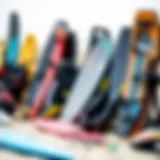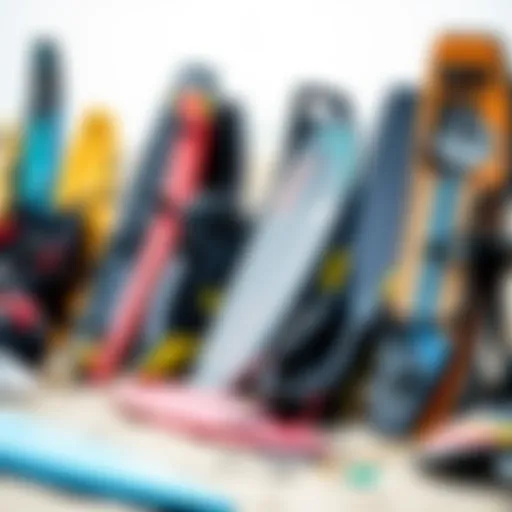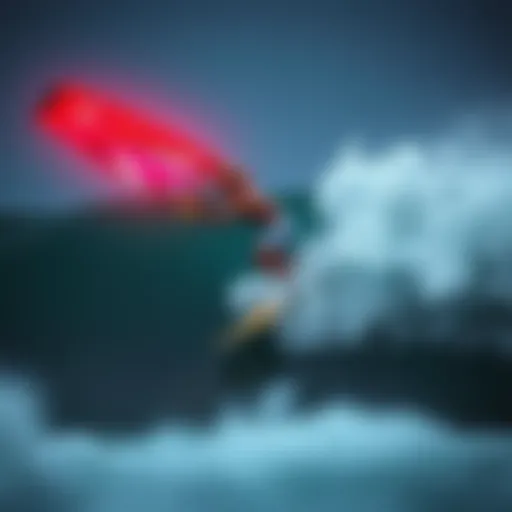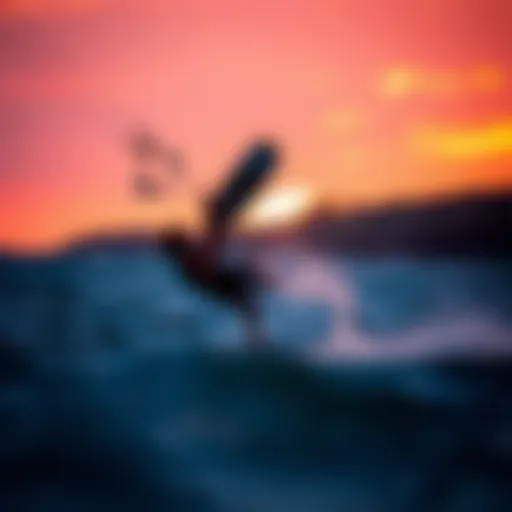Wind Forecast Insights for Los Angeles Kiteboarding
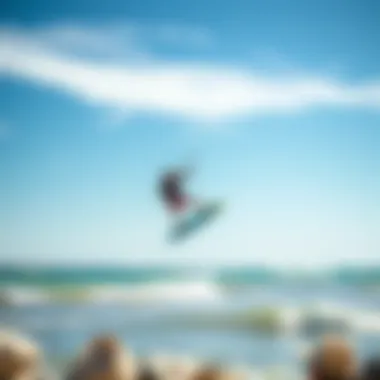
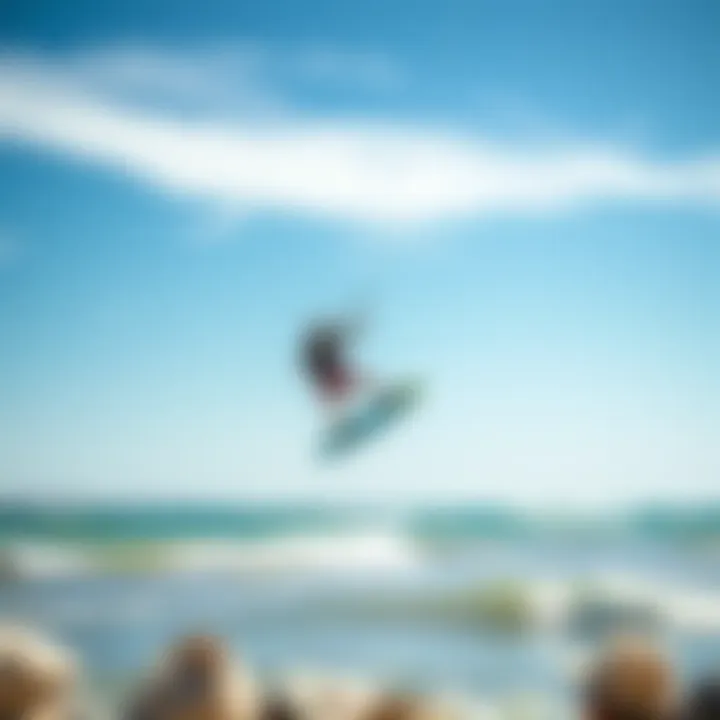
Gear Selection
When it comes to kiteboarding in Los Angeles, selecting the appropriate gear plays a pivotal role in both safety and performance on the water. Like any sport, having the right tools can mean the difference between a smooth ride and an uncomfortable experience.
Types of Kites
There are several types of kites to consider, each tailored for different wind conditions and rider preferences. Generally speaking, a few major categories stand out:
- C-Kites: Known for their power and control, C-kites are favored by experienced riders who enjoy freestyle tricks. They have a more direct line of pull, making them ideal in strong winds.
- Bow Kites: These kites are popular among beginners due to their ease of use and stability. They have a larger wind range and can generate a lot of lift, which can be advantageous for novice skill development.
- Delta Kites: Versatile and forgiving, delta kites are a great option for a variety of riding styles. They perform well in lighter winds and gradual gusts, which can often be found during an afternoon in Los Angeles.
Choosing the right kite can significantly affect your experience. It’s essential to match your selection to both your skill level and the expected wind conditions for the day.
Choosing the Right Board
The board, coupled with the kite, completes the kiteboarding setup. Selecting a board should be a thoughtfully considered decision:
- Twin-Tip Boards: The most common type, they allow riders to ride in both directions easily. They are especially handy for short-distance maneuvers and are a good fit for beginners who may experience some falls.
- Directional Boards: Best suited for those looking to ride waves or perform more advanced techniques. They require more skill to handle and are typically more stable in high-speed situations.
- Foil Boards: Gaining popularity, especially for those looking to ride lighter winds. They hover above water and can give a unique experience by gliding over waves.
Your choice in boards should align with what kind of riding you plan to do, as well as the wind conditions expected that day, which plays a significant role in the overall experience.
Skill Development
Enhancing your kiteboarding skills, particularly in a location like Los Angeles, involves constant practice and a willingness to adapt to conditions. The winds might shift from day to day, and so must your technique.
Essential Techniques
Many techniques are fundamental to kiteboarding:
- Diving: Learning how to dive the kite smoothly will help you generate speed and lift. Practice pulling down on the back lines while keeping your eyes on the board.
- Transitions: Working on smooth transitions will help you turn efficiently without losing energy. Focus on weight distribution and edging.
- Jumping: Getting air can be intimidating but practice is key. Start with small jumps and gradually seek higher altitude. This not only boosts confidence but adds excitement to your sessions.
Progression Tips
Invest time in refining your techniques and consider the following tips for progression:
- Consistent Practice: Try to hit the water regularly. The more time you spend practicing, the quicker you will improve.
- Analyze Your Rides: After a session, think about what went well and what didn’t. This self-reflection will help advance your skills.
- Seek Guidance: Engaging with local instructors or seasoned kiteboarders can provide valuable insight and direct feedback on your techniques. Sometimes, an outside perspective can make a significant difference.
"Understanding the wind and practicing with the right gear is the backbone of successful kiteboarding!"
Once you start understanding your gear and enhancing your skills, you'll notice the light of every kite session shining bright, especially in the breezy coastal stretches of Los Angeles.
For more helpful info on kiteboarding gear and developments, explore Kite Forum or check out discussions on Reddit Kiteboarding.
Preface to Wind Conditions in Los Angeles
In the realm of kiteboarding, the wind is not just a backdrop; it is the lifeblood that fuels the sport. In Los Angeles, understanding the nuances of wind conditions can be the difference between a thrilling ride and a frustrating day on the water. Kiteboarders, whether they are beginners or seasoned pros, need to have a firm grasp on how local wind patterns operate.
The importance of harnessing wind in kiteboarding cannot be understated. The right wind conditions empower riders to perform at their best, ensuring safety and enjoyment while they glide over the waves. Knowledge of the local wind behavior enables kiteboarders to plan their sessions effectively, choosing the best times and spots to hit the water.
Los Angeles has a vibrant kiteboarding community, making it essential for participants to stay informed about conditions that could affect their experience.
Importance of Wind for Kiteboarding
Kiteboarding relies heavily on wind, as it propels the rider and provides the lift necessary to perform maneuvers. Understanding wind direction and speed is pivotal. For instance, onshore winds tend to be gentler and can be safer for beginners, while offshore winds may offer more challenge and excitement for experienced riders. Wind not only affects speed and control but also influences safety measures when taking to the water.
Additionally, local environmental factors, such as coastal features and temperature variations, play a significant role in wind dynamics. Riders who are attuned to these specifics can greatly enhance their performance and experience, ensuring they’re in sync with the wind rather than battling against it.
Overview of Los Angeles Kiteboarding Scene
Los Angeles boasts an extensive kiteboarding scene, drawing enthusiasts from all walks of life. The wide array of urban beaches provides numerous locations to kiteboard, each with its distinct flavor and characteristics. Areas like Santa Monica and Playa del Rey are well-known for their accessible conditions and vibrant communities. It’s not just about riding; the sense of camaraderie is palpable among kiteboarders.
Furthermore, local events and competitions showcase the talent within the community, allowing both amateurs and professionals to test their skills and connect with each other. Local shops and instructors are eager to share their knowledge, offering lessons and gear for riders of all skill levels.
By diving into the wind conditions specific to Los Angeles, riders can not only enhance their skills but also become integral members of this engaging community.
Meteorological Factors Affecting Wind Patterns
Wind patterns play a crucial role in determining kiteboarding conditions. Understanding the meteorological factors that influence these patterns is vital for anyone looking to maximize their time on the water. Several elements, including geography, local weather systems, and seasonality, significantly affect wind behavior in Los Angeles. By grasping these concepts, kiteboarders can better anticipate when and where to ride safely and effectively.
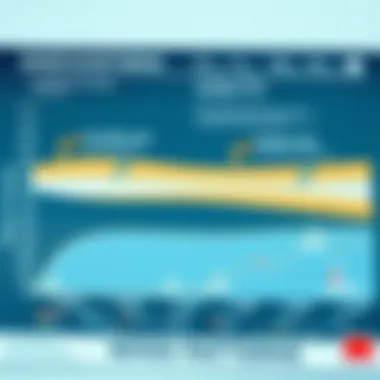
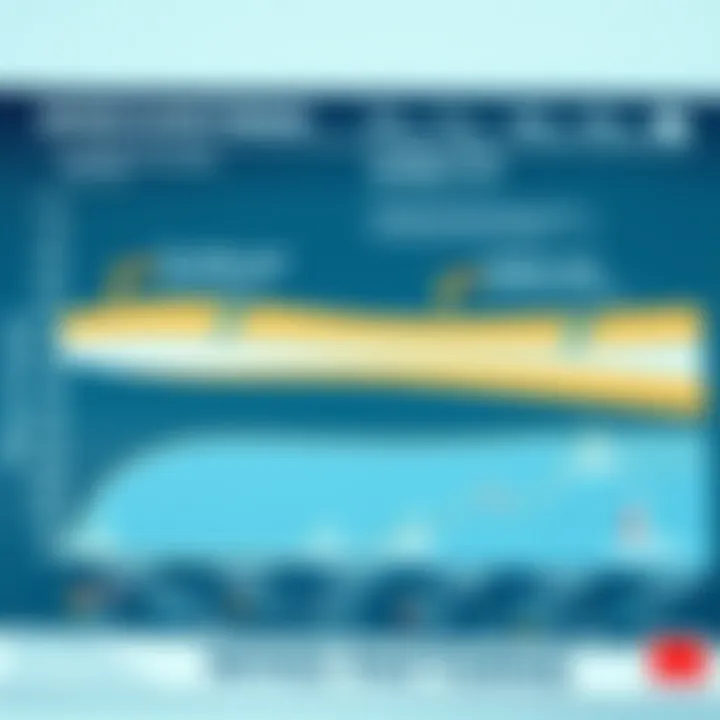
Geographical Influence
Los Angeles is adorned with a coastline that stretches along the Pacific Ocean, separated from the mountain ranges to the north by the Santa Monica Mountains. This geographical setup has a profound impact on local wind patterns. The mountains can create pressure differences that funnel and accelerate winds, often referred to as mountain breezes or canyon winds.
For example, at places like Topanga State Park, you might find stronger winds funneled through the canyons, particularly in the afternoon as heat builds during the day. On the flip side, nearby bay areas, like Marina Del Rey, might experience lighter winds.
Kiteboarders need to consider these geographical influences, as they can determine which spots offer the most favorable conditions during different times of the day. All in all, understanding how location affects wind speed and direction can make or break a kiteboarding session.
Local Weather Systems
Los Angeles weather can be a mixed bag, thanks to its Mediterranean climate. Local weather systems significantly influence daily wind patterns. The ocean's surface temperature often dictates the wind; warmer air over land rises, pulling cooler ocean air inland. This creates what’s known as a sea breeze, a critical consideration for kiteboarders.
In the summer, this sea breeze can kick in around midday, delivering consistent, steady winds ideal for kiteboarding. Events, such as marine layer formations or Santa Ana winds, can temporarily disrupt these predictable patterns.
Kiteboarders should keep an eye on local weather forecasts and understand these weather systems, as knowledge about thermal dynamics and the influence of pressure systems can provide insights into when the wind will be best for riding. Resources like NOAA can offer excellent weather insights for kiteboarders searching for real-time data.
Seasonal Variations
Understanding the seasonal variations in wind patterns is essential for kiteboarding enthusiasts. In Los Angeles, the winds are generally more favorable from late spring to early fall. In these months, the broader atmospheric conditions tend to support stronger and more consistent winds.
Spring often brings moderate wind conditions, great for both beginner and intermediate riders. In contrast, summer offers the strongest winds, perfect for more experienced kiteboarders looking to push their limits.
However, as fall sets in, winds can become a bit unpredictable, sometimes dropping significantly in speed or shifting direction altogether. Winter may bring entirely different dynamics with sporadic windy days influenced by weather fronts.
For a successful kiteboarding experience, tracking these seasonal changes can significantly improve one’s understanding of when to hit the water for optimal riding conditions.
In summary, kiteboarding in Los Angeles requires a grasp of the geographical influence, local weather systems, and seasonal variations. This knowledge empowers riders to make informed decisions about their sailing adventures.
Analyzing Wind Forecasts
Analyzing wind forecasts is crucial for anyone involved in kiteboarding, especially in a dynamic location like Los Angeles. Wind is the backbone of kiteboarding; without it, the sport simply cannot happen. Understanding how to read and analyze wind forecasts can mean the difference between a fantastic session on the water and a disappointing day spent waiting for favorable conditions. This section aims to clarify the importance of these forecasts, key metrics to keep an eye out for, and sources where reliable information can be found.
Key Metrics to Consider
When assessing wind forecasts, there are several key metrics that kiteboarders should prioritize. These metrics inform not only the safety of a kiteboarding session but also the overall experience. Here are the essentials:
- Wind Speed: This is perhaps the most obvious and critical metric. The ideal wind speed varies by skill level and kite size, so knowing the average expected winds helps determine if conditions are suitable for your gear.
- Wind Direction: Understanding wind direction greatly influences your approach to kiteboarding. Cross-shore winds can provide a more enjoyable and safer experience than turbulent on-shore winds which could bring unexpected hazards.
- Gusts: Taking note of gusty winds is essential as they can impact control. A steady breeze is generally preferable; irregular gusts can throw even the most seasoned kiteboarders for a loop.
- Weather Conditions: Wind may not be the only factor at play. Cloud cover, humidity, and precipitation can also affect wind conditions. Always take into account the overall weather forecast.
These metrics are often available on various forecasting platforms; however, understanding them allows riders to adapt to changing conditions and enhances the overall kiteboarding experience.
Sources for Reliable Wind Data
Finding reliable sources of wind data is equally important in analyzing forecasts. Kiteboarders need to know where to look to get accurate and up-to-date information. Here are some valuable resources:
- National Weather Service (NWS): The NWS provides comprehensive weather updates, including wind forecasts. Their data is generally reliable because it comes straight from government meteorologists.
- Windy: This website offers interactive maps showcasing wind patterns, speed, and direction. It’s user-friendly and favored by many kiteboarders.
- Kiteboarding and Wind Sports Forums on Reddit: Engaging with community members can yield invaluable insights and real-time updates.
- Buoy Data: For those willing to dig a bit deeper, buoy data for coastal areas can provide localized wind readings. Websites like NOAA (National Oceanic and Atmospheric Administration) have this data.
"Staying informed about wind conditions means never missing a session. Use reliable sources, and make every kiteboarding trip count!"
In summary, analyzing wind forecasts is an essential part of kiteboarding in Los Angeles. By honing in on key metrics and utilizing trustworthy resources, riders can make well-informed decisions, ensuring they hit the water when conditions are just right.
Tools for Monitoring Wind Conditions
In the world of kiteboarding, understanding wind conditions is paramount for ensuring a safe and enjoyable experience. For that reason, having the right tools for monitoring wind conditions can make a significant difference. These tools not only enhance awareness but also help in planning sessions around optimal kiteboarding conditions.
With the broad range of technologies available today, kiteboarders can access real-time data at their fingertips, enabling them to make decisions based on accurate information. This article section will delve into mobile applications and web-based forecasting platforms available to enhance decision-making when it comes to kiteboarding in Los Angeles.
Mobile Applications for Wind Tracking
Mobile applications have made significant strides in providing accurate wind forecasts for kiteboarders. They put essential information right in the palm of your hand, allowing for quick and informed decisions while out and about. Essential elements to consider when evaluating mobile apps include:
- User-Friendliness: The best applications have intuitive interfaces that make accessing wind data simple. A clean layout means you can effortlessly navigate through various wind metrics without getting lost in complexity.
- Real-Time Updates: Wind conditions can change in a flash. Having an app that offers real-time updates ensures you're aware of sudden changes that could affect your safety or riding enjoyment.
- Detailed Forecasts: Look for applications that provide comprehensive forecasts, including wind speed, temperature, wind direction, and even local gust factors. A versatile application like Windy or KWind can offer these metrics and more, giving you the whole picture at a glance.
- Community Insights: Some applications even incorporate social features that allow users to report current conditions. This peer feedback can enhance forecast accuracy, as it reflects on-the-ground reality rather than mere predictions.
For example, KiteLog allows enthusiasts to record conditions at specific spots and shares a community-generated database of wind patterns, which is instrumental for making informed decisions.
Web-Based Forecasting Platforms
Once you’ve scoped out mobile apps, it’s also worth jumping into some robust web-based forecasting platforms. These sites often provide a more comprehensive look at various weather patterns and conditions. Here are some points of interest:
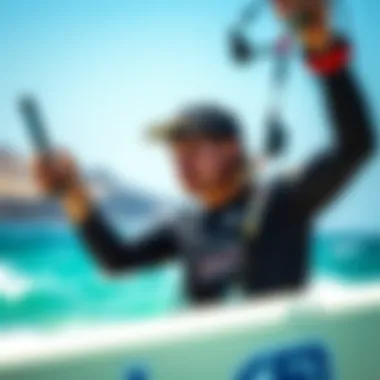
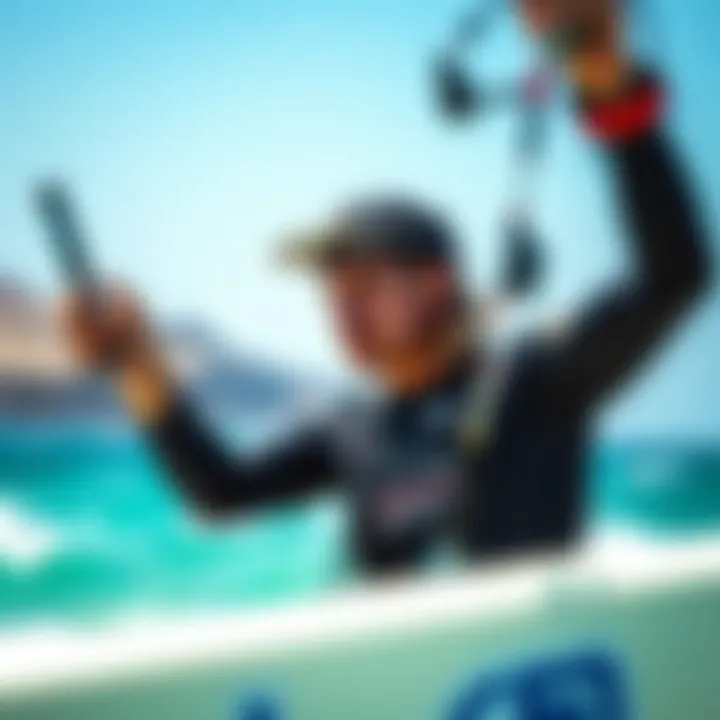
- In-Depth Analysis: Web platforms like Magicseaweed provide comprehensive wind forecasts alongside other data like wave conditions. Users can dive into detailed geographical maps that showcase specific regions, vital for understanding different kiteboarding locations in Los Angeles.
- Customizable Alerts: Many of these platforms allow users to set alerts for specific wind conditions. This means you can get pinged when it’s time to hit the beach based on your criteria.
- Visualization Tools: Interactive visualizations can help you easily digest complex data. Charts and graphs that display shifts in wind speed can provide valuable insight for upcoming kiteboarding outings.
- Comparative Forecasts: Unlike mobile apps that may rely on specific weather stations, web platforms often aggregate data from multiple sources, giving a broader view of what to expect for any given day or week.
In summary, utilizing mobile apps alongside web-based forecasting platforms can significantly enhance a kiteboarder's ability to assess wind conditions in Los Angeles. With the right tools, it’s easier to choose those perfect moments when the wind is just right for kiteboarding, ultimately leading to a more enjoyable and safe experience on the water.
"Good decisions require good information."
Whether you’re a beginner or an experienced rider, taking a step to use these tools will surely elevate your kiteboarding experience.
Kiteboarding Locations in Los Angeles
When it comes to kiteboarding in Los Angeles, the choice of location can make or break your day on the water. Finding the right spot plays a crucial role in not only ensuring a great kiteboarding experience but also maximizing safety and performance. L.A. boasts diverse coastal landscapes and varying wind conditions which make it a playground for kiteboarders of all skill levels. Take the time to explore these options and you’ll quickly learn why the right terrain and wind patterns matter.
Best Beaches for Wind Engagement
Los Angeles is home to several prime kiteboarding beaches that cater to both beginners and seasoned riders. Here are a few spots that stand out:
- Kite Beach in Playa del Rey: Known for its consistent wind and ample space, Kite Beach is a favorite among locals. The area is a hotbed for various kiteboarding activities and offers a friendly atmosphere. Beginners can find plenty of instructors here, making it the perfect launch pad for those new to the sport.
- Topanga Beach: This beach offers breathtaking views and a natural setting, but it can be tricky if you're inexperienced. Strong winds can lead to challenging conditions, but for those who know their stuff, the thrill is electrifying.
- Dockweiler State Beach: A quieter alternative compared to its neighboring beaches, Dockweiler boasts much smoother water, making it suitable for those looking to perfect their jumps and tricks without much interruption.
These beaches not only provide great wind conditions but also have a vibrant community with practical amenities, which can enhance your overall kiteboarding experience.
Hidden Gems for Advanced Riders
For the more experienced kiteboarders looking to step off the beaten path, Los Angeles presents some hidden gems that promise unique challenges and spectacular landscapes. Consider these spots:
- Will Rogers State Beach: Locally loved, this more secluded beach offers the chance to ride alongside dolphins if you’re lucky. The wind can whistle through the canyons, creating some exhilarating conditions that seasoned riders crave.
- El Porto: Tucked away in Manhattan Beach, El Porto is less crowded and can be a fantastic spot when the winds are right. Advanced riders report that this location can produce epic rides with substantial swells.
- Malibu Lagoon: While often overshadowed by more famous beaches, Malibu Lagoon can be a real playground for advanced kiteboarders. With less mainstream traffic, it allows for truly undisturbed riding, ensuring you focus on perfecting your moves rather than navigating through crowds.
By exploring these kiteboarding locations in Los Angeles, riders can not only enjoy the thrill of the sport but also appreciate the stunning scenery and unique conditions each spot offers. Paying attention to wind and environmental factors at these locations will help you enhance your skills and ensure a safer, more enjoyable experience on the water.
"The best place to ride is not just about the wind but also the vibe of the spot. Always check the local conditions before heading out."
For more information about local conditions and guidelines, check out Windy.com or visit Kiteboarding.com for community insights and tips.
Understanding Wind Direction and Its Impact
Understanding wind direction is paramount for kiteboarders. The way the wind blows can drastically affect not just the quality of your ride, but also your overall safety out on the water. There’s a world of difference depending on whether the wind is blowing offshore, onshore, or cross-shore. Each scenario presents unique conditions that can make for a stellar day of kiteboarding or a risky endeavor. You must grasp these nuances to ensure optimal performance and safety on the water.
Cross-Shore vs On-Shore Winds
When you’re out kiteboarding, the wind's direction can set the tone for your entire experience.
- Onshore Winds are those that blow from the sea towards the land. For kiteboarders, these can be beneficial as they usually provide great lift and allow for consistent and stable rides.
- Cross-Shore Winds blow parallel to the shore. They can be fantastic for those who enjoy maneuvering between the waves, as they give a balanced feeling. However, some might find them a bit tricky, as it can make it harder to gauge the wind's strength while close to the shoreline.
- Lastly, it’s worth mentioning Offshore Winds, which blow from the land to the sea. These winds pose significant risks, particularly if you find yourself drifting further away from the shore. It’s essential to approach any kite session with caution in these conditions.
Thus, recognizing these wind types and their implications is crucial. Knowing when the wind is right for your skill level and what direction it's coming from can make all the difference.
Evaluating Safety Based on Wind Direction
Safety can’t be overstressed when kiteboarding. Wind direction directly influences potential hazards such as gusty conditions, equipment malfunction, and even your ability to return safely to shore.
- Onshore Wind Safety Considerations: When riding in onshore winds, you need to be especially mindful of how close you are to the shore, the crowd and obstructions in the water. Always maintain a clear escape route in case wind speeds increase unexpectedly.
- Cross-Shore Safety Aspects: Cross-shore winds can lead to an adventurous ride if you’re skilled but remember that the risks are higher. It can carry you out further than you plan. Stay alert to your distance and ensure your return path is clear. Trainers or instructors often advise keeping a constant eye on the wind's behavior to avoid getting trapped.
- Offshore Wind Risks: This is probably the trickiest wind. If the flow starts to pick up, you risk being blown out to open water. Keep in mind that if something goes wrong, getting back can be challenging. If you see signs of stronger offshore winds, it's better to stay grounded.
The Role of Wind Speed in Kiteboarding Performance
Wind speed is a pivotal factor in kiteboarding that can significantly influence a rider's experience on the water. Understanding this element allows both novice and experienced kiteboarders to rotate through their maneuvers with skill and confidence. It’s not just about how fast the wind blows, but how that speed interacts with the kite, the rider’s abilities, and the specific dynamics of a kiteboarding session.
One important aspect is that the wind speed dictates the power generated by the kite. The right wind speed can elevate your performance, enabling smoother jumps, radical tricks, and longer rides. In environments like Los Angeles, where conditions can be vibrant yet variable, grasping wind speed and its role aids in choosing the optimal time and location for kiteboarding sessions.
"Successful kiteboarding hinges not only on skill but on understanding the nature of wind. It can turn a good day into a spectacular one or a challenging one into a regrettable experience."
Moreover, different skill levels demand varying wind speeds. Beginners may find themselves struggling with high winds, while seasoned riders thrive in those gusts. Recognizing which speeds align with your proficiency level is essential for both safety and enjoyment on the water.
Furthermore, wind speed serves as a linchpin linking numerous elements of kiteboarding together. From equipment selection to safety considerations, understanding wind speed fosters better decision-making. Riders can analyze conditions accurately and prepare accordingly, thereby enhancing their overall kiteboarding experience.
Optimal Wind Speeds for Different Skill Levels
When it comes to optimal wind speeds, understanding your own skill level is the key to unlocking the best kiteboarding experience. Kiteboarding enthusiasts can generally categorize their skills into three levels: beginner, intermediate, and advanced.
- Beginners often do well in wind speeds of 10 to 15 knots. These calmer breezes allow for the learning of essential skills like balance and control without overwhelming anxiety about chop and fast-moving gusts.
- Intermediate riders may start to enjoy wind speeds between 15 to 25 knots. This range allows them to practice more dynamic techniques while still having room for error without dangerously overpowering conditions.
- Advanced kiteboarders, who are ready for high-adrenaline maneuvers, can thrive in winds of 25 knots and above. These speeds can help them execute high jumps and complex tricks, but only if they are comfortable with managing the added control needed in such winds.


Understanding these ranges helps riders select the appropriate gear and plan their sessions effectively. An ill-advised venture into too strong or weak winds can lead to accidents or missed opportunities.
Wind Speed Calculation Techniques
Calculating the wind speed effectively can empower kiteboarders to make informed choices about when and where to kite. Here are some techniques that can help riders gauge wind conditions:
- Anemometers: These handy tools measure wind speed at your kiteboarding location. With options available for handheld or smartphone integration, they provide real-time data.
- Wind Charts and Forecasts: Websites and mobile apps provide yearly or monthly wind data based on historical patterns. Resources like Windy and Kitefinder are popular among kiteboarding enthusiasts.
- Visual Indicators: Observing the water can provide clues. If the water shows rough patches or whitecaps, it often indicates stronger winds. However, interpreting these visual signs requires experience.
- Consider Local Conditions: Different locations in Los Angeles will experience varying wind speeds due to topography and prevailing weather patterns. Always adjust your expectations based on the specific spot you choose.
By employing these techniques, riders can better prepare for their kiteboarding sessions, ensuring they encounter the most favorable conditions for their skill level and objectives.
Implications of Wind Conditions on Events
When it comes to kiteboarding, wind conditions can be the deciding factor between an exhilarating day on the water and a frustrating one spent watching from the shore. The implications of these wind conditions extend beyond just recreational kiteboarding – they affect competitions, safety measures, and the overall kiteboarding scene in Los Angeles.
Planning Competitions Based on Forecasts
Organizing a kiteboarding competition requires meticulous planning, and understanding wind forecasts is at the heart of it. Events can be significantly impacted by the wind strength and direction, calling for a solid strategy when scheduling heats. Competitive kiteboarders thrive within certain wind parameters, so using accurate forecasts allows event organizers to maximize performance and safety.
Here’s how the process unfolds:
- Criteria for Choosing Competition Days: A competition might be labeled ‘on’ or ‘off’ based on the prevailing forecasts. Organizers often rely on reports from systems like NOAA (https://www.noaa.gov) or specialized apps that track real-time conditions.
- Flexibility is Key: Sometimes, adjustments are necessary. Letting participants know ahead of time that there could be last-minute changes based on wind patterns is crucial. If forecasts predict a sudden increase in wind gusts, events might need to be restructured or rescheduled.
- Feedback Loop: After a competition, revisiting the forecasts against actual conditions can provide insights for organizing future events, helping to refine criteria and attendance.
"Wind is a fickle friend; understanding its mood shapes the entire kiteboarding experience."
The importance of these aspects cannot be overstated. Well-planned events can lead to better performances, excited athletes, and cheering crowds.
Safety Protocols During High Wind Events
Dealing with high wind events isn’t just about thrill seeking; it’s a matter of safety. Wind conditions can change in a heartbeat, and being vigilant is part of responsible kiteboarding. Implementing effective safety protocols is essential for protecting everyone involved.
Here are some considerations to keep in mind:
- Pre-Event Assessments: Before heading out, both participants and organizers must assess wind conditions. If forecasts suggest gusts beyond skill levels for most riders, it’s wise to postpone or limit activities.
- Communication is Essential: Providing clear channels of communication, whether through group messaging apps or social media, keeps everyone informed about potential hazards or changes in plans.
- Equipment Check Lists: Riders should have a checklist for safety gear and equipment conditions based on wind conditions. Items such as harnesses, lines, and boards should be regularly inspected to avoid accidents.
- Buddy System: Implementing a buddy system ensures that kiteboarders look out for each other during high-wind days. A fellow rider can help with spotting and rescuing if needed.
- Post-Event Review: After high wind events, discussing what worked and what didn’t can help prepare for future encounters with adverse conditions.
In the world of kiteboarding, preparedness trumps spontaneity. Adapting to wind conditions ensures that the thrill of the sport is matched by the safety of those who love it. Understanding both the logistics of event planning and the intricacies of safety protocols can dramatically enhance the quality of kiteboarding events in Los Angeles.
Environmental Considerations Related to Wind
In the vibrant world of kiteboarding, acknowledging the environmental considerations linked to wind conditions is paramount. Understanding how kiteboarding interacts with local ecosystems not only fosters a healthier relationship between the sport and nature, but also informs riders about their responsibilities as enthusiasts of this thrilling activity.
Impact of Kiteboarding on Local Ecosystems
Kiteboarding, while exhilarating, does not come without its own set of ecological footprints. The areas along the coast of Los Angeles house delicate marine environments, teeming with life. When kiteboarders flock to their favorite spots, the potential for disruption to local wildlife becomes a pressing concern.
- Wildlife Disturbance: Kiteboarding in particular locations can stress birds that nest or forage in these areas. For instance, during nesting seasons, beaches might harbor birds like the California least tern, which could be adversely affected by the presence of riders.
- Erosion and Habitat Damage: The frequent launching and landing on certain beaches can contribute to erosion, altering natural habitats that are crucial for various species. Additionally, careless navigation through shallow waters can damage seagrass beds or coral reefs.
- Water Quality: The debris left behind, such as broken equipment or personal waste, can pollute local waters, affecting marine organisms. Protecting water quality is critical for the health of both marine life and human recreation.
Ultimately, it’s vital for kiteboarders to be mindful of their surroundings. Being informed and creating awareness about these impacts can influence behaviors that promote environmental sustainability, ensuring future generations can enjoy similar sports without compromising ecological balance.
Sustainable Practices for Kiteboarders
Kiteboarders hold the power to be ambassadors for the environment by adopting sustainable practices that can help mitigate the potential negative impacts on ecosystems. To balance excitement with responsibility, engaging in eco-friendly habits is essential. Here are several ways kiteboarders can practice sustainability:
- Leave No Trace: Riders should adhere to the principles of Leave No Trace. This includes packing out what you bring in, ensuring beaches and waters remain free of litter.
- Choose Your Launch and Landing Zones Wisely: Seek out designated areas for launching and landing to minimize disturbance to wildlife habitats. It’s wise to stay away from sensitive regions, particularly during nesting seasons.
- Educate Fellow Riders: Sharing knowledge about the importance of environmental stewardship can create a ripple effect within the kiteboarding community. Discussing the ecological significance of local spots can spur collective action in recognizing and preserving these areas.
- Participate in Environmental Initiatives: Engage in local clean-up events or conservation programs. Many organizations around Los Angeles are committed to preserving coastal areas, and contributing to such projects can make a significant difference.
- Use Eco-Friendly Products: When purchasing gear or accessories, select products from companies that prioritize sustainability in their manufacturing processes. Many brands are moving toward biodegradable materials and responsible sourcing.
End
In summation, having a clear grasp of wind forecast principles is essential for anyone involved in kiteboarding within the vibrant backdrop of Los Angeles. Wind conditions dictate more than just the ability to glide through the water; they play a pivotal role in enhancing safety and optimizing performance.
Kiteboarders benefit by recognizing a few key aspects:
- Wind Behavior: Understanding how local geography influences wind patterns can help riders select the ideal time and location to hit the waves. This means knowing when to expect the infamous Santa Ana winds or the breezier days along the coast.
- Forecast Tools: By utilizing various wind tracking applications and reliable web platforms, riders can make real-time decisions. Each tool offers insights rooted in local meteorological data, which can be the difference between an exhilarating ride and a frustrating day on the beach.
- Environmental Responsibility: Given the profound relationship between kiteboarding and local ecosystems, awareness of wind conditions can guide kiteboarders in practicing sustainable habits. Adjusting one’s actions according to wind forecasts can minimize negative impacts on wildlife and coastal areas.
Further, for instructors and event organizers, strong knowledge of wind conditions can enhance competition planning and safety protocols, ensuring a smooth and enjoyable experience for all.
Ultimately, staying informed about the wind is not merely a supplementary skill for kiteboarders; it's integral to mastering the sport in Los Angeles. As the local scene continues to evolve, so does the necessity for enthusiasts at every skill level to remain engaged with these wind dynamics, paving the way for unforgettable adventures on the water.
"Success in kiteboarding relies heavily on the wind; understanding it ensures not just enjoyment, but also safety and sustainability."
Key Takeaways for Kiteboarders
- Know your winds: Familiarize yourself with local wind patterns and seasonal changes, optimizing your kiteboarding sessions accordingly.
- Embrace technology: Use smartphone apps and web platforms that supply live wind data to stay ahead of rapidly changing conditions.
- Consider the environment: Practice conscientious kiteboarding by being aware of your surroundings, leading to a healthier space for both riders and local habitats.
- Seek community insights: Engaging with local kiteboarding forums or social media groups can provide real-time tips and experiences from other riders.
- Prioritize safety: Always check conditions prior to heading out, especially during high wind scenarios and remember to respect your limits based on your skill level.
By keeping these takeaways in mind, kiteboarders in Los Angeles can make the most of their time on the water while ensuring a safe and enjoyable experience.






